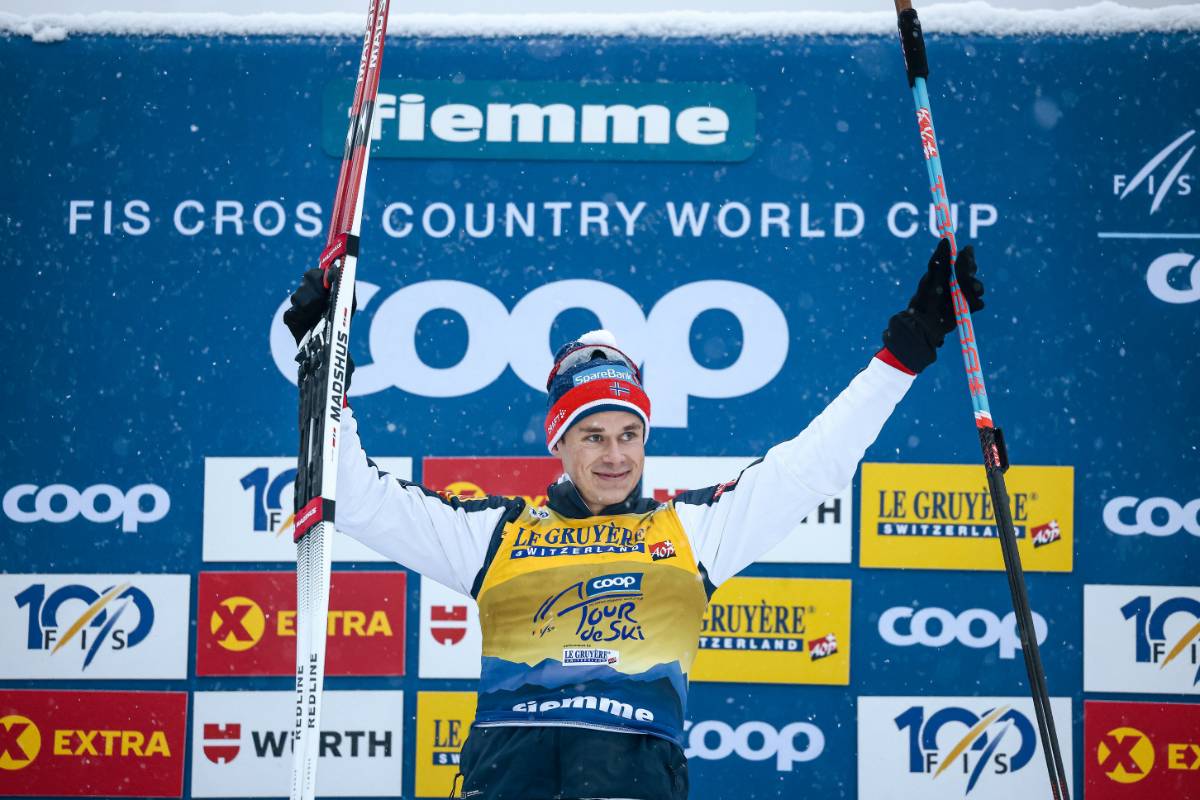 This coverage is made possible through the generous support of Marty and Kathy Hall and A Hall Mark of Excellence Award. To learn more about A Hall Mark of Excellence Award, or to learn how you can support FasterSkier’s coverage, please contact info@fasterskier.com.
This coverage is made possible through the generous support of Marty and Kathy Hall and A Hall Mark of Excellence Award. To learn more about A Hall Mark of Excellence Award, or to learn how you can support FasterSkier’s coverage, please contact info@fasterskier.com.
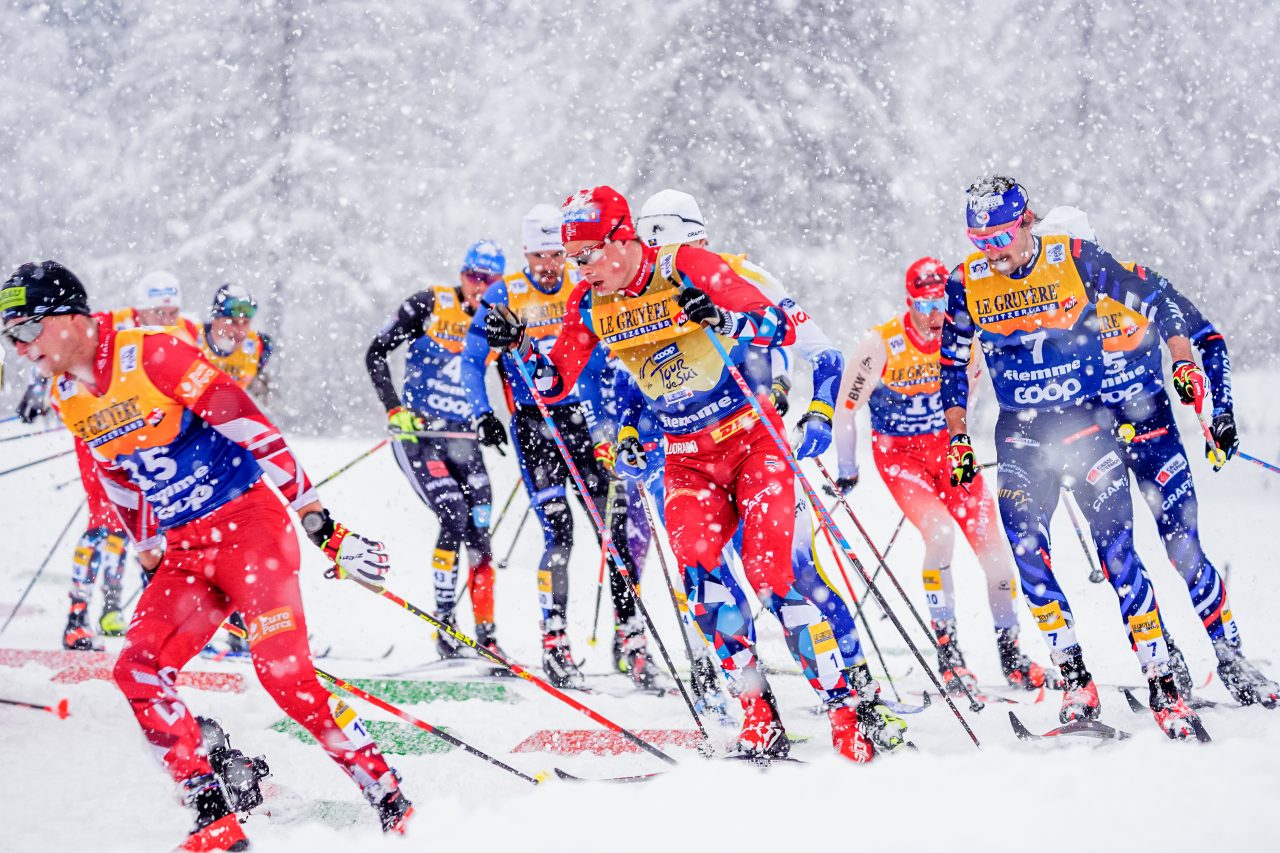
The men’s Tour de Ski (TDS) began last week with team Norway back on its heels as France and the USA challenged Norway’s domination; that seems a lifetime ago. Ever since the third race, in Toblach, Italy, Norway has been dominant again with no other country really giving it a run for the overall title. The Tour is Harald Oestberg Amunden’s (NOR) to take. Going into today’s 15 kilometer Mass Start Classic race, in Val Di Fiemme, Italy, Amundsen is 1:39 ahead of countrymen Henrik Doennestad, and Martin Loewstroem Nyenget.
But a very tantalizing question remains as to whether a non-Norwegian man can find the podium at the end of the Tour? As to that question, the answer is a definite: it’s possible. Hugo Lapalus (FRA) is only two seconds out of second place behind Doennestad and Nyenget. Likewise, Friedrich Moch (GER) and Beda Klee (SUI) are only seconds behind the Norwegian duo. So, while the race for the top spot is definitely Amundsen’s to lose, other countries are knocking on the door to gain a spot on the podium.
A 15 kilometer mass start Classic race is a tough format in which to gain ground, so any efforts by Lapalus and Moch to join the Tour podium leaders would be a tall task. They couldn’t risk too much today as they would need to leave themselves in contention for Sunday’s final race, the climb up Alpe Cermis. But given the razor thin margins separating second and seventh place of only eight seconds, it wouldn’t take much to dislodge the current Norwegian monopoly. The men’s race for first place might lack the drama of the women’s, but the race for second and third is scorching hot.
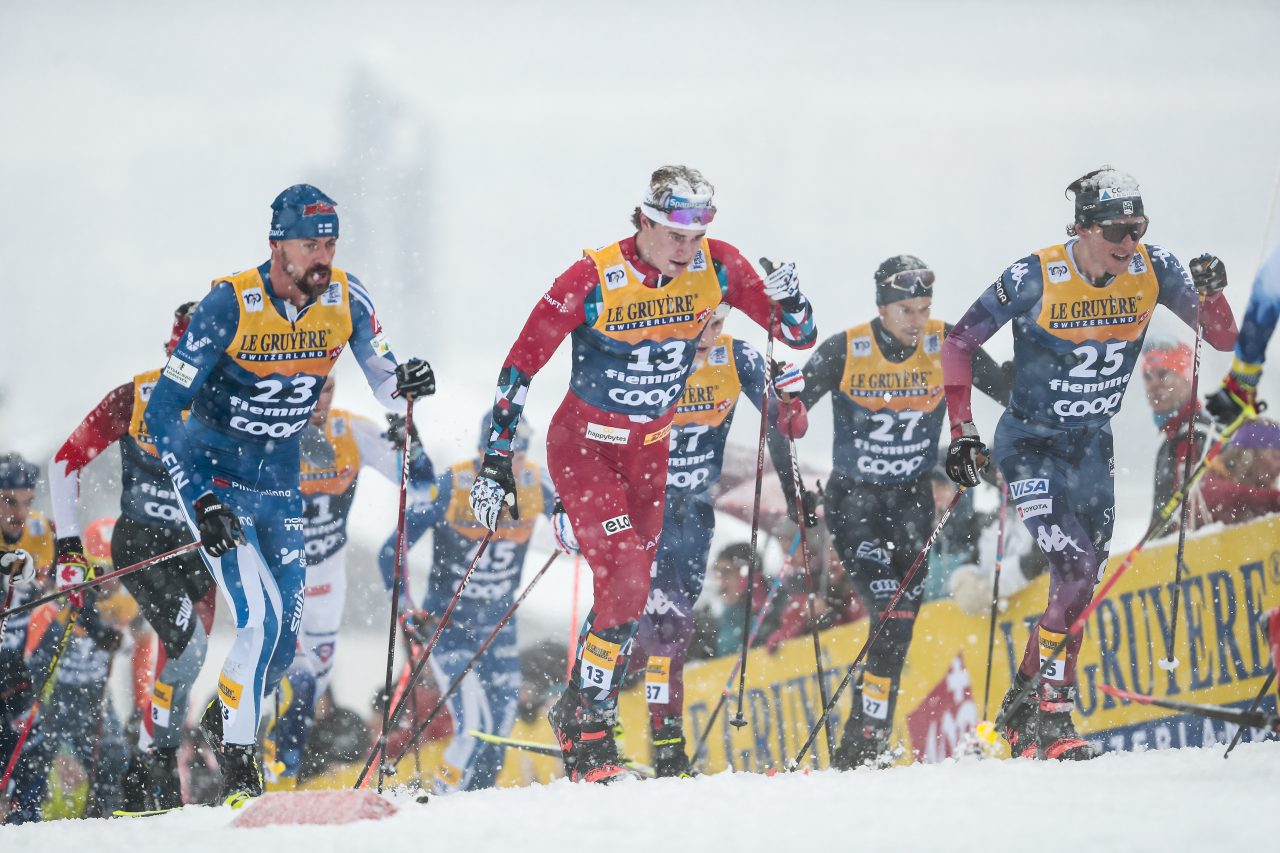
For the American men, the bright promise they showed early in the Tour has faded away as illness decimated the team; just as it has much of the Tour. There were only two Americans left on the start line, Scott Patterson, (4:54 behind the Tour leader, and Zanden McMullen (7:37 behind the Tour leader).
At the conclusion of a very tactical race, it was Erik Valnes (NOR) taking the victory. He was followed by William Poromaa (SWE) in second, and Cyril Faehndrich (SUI) third. American Scott Patterson had a nice day finishing 27th, only 16 seconds off the lead. He was closely followed by Zanden McMullen in 31st, 17 seconds behind first.
The top Canadian finisher was Olivier Leveille in 33rd, and Antoine Cyr in 41st.
An interesting finishing time was delivered by Sprinter Lucas Chanavat who has continued with the Tour even after the Sprints were concluded. He finished 54th, the last skier to finish, 3:37 behind the leaders and over 1:40 behind the second to last skier. It could be debated whether it’s sandbagging or smart tactics by the Sprinter to keep his Tour alive.
Men’s 15 Kilometer Classic Mass Start Race
Much like the Classic race two days ago in Davos, skiers again faced extremely challenging waxing conditions in Val di Fiemme. It was snowing hard with temperature right around freezing. Again, wax technicians faced difficult choices. As racers marched to the start line to begin the race, lots of zero skis could clearly be seen; along with some skiers choosing klister. The American men were split on ski setup. According to U.S. coach Kristen Bourne, Patterson chose zero skis while McMullen was on klister. Bourne told FasterSkier that zeroes and klister skis were tested for both the men’s and women’s races with a mix of skis finally selected for both races. “It was definitely a mixed bag,” said Bourne. “Another day of our kick team really working trying to figure it out.” The decision was ultimately the athlete’s to make. “The skier and the tech would talk about it and make the decision together.” But the new fluoro rules threw another curve into ski choice. Under the rules for Classic races, skiers are allowed to present two pairs of skis for pre-race fluoro testing 30 minutes before the start. Bourne indicated that it’s ultimately the athlete’s choice to decide which pair of skis to choose from between the two pair which clear fluoro testing; a fairly nerve wracking dilemma. Things become even more complex as there is a kick adjustment zone after skis have been fluoro tested where kick zones, and only kick zones, can be adjusted just before the race.

Unlike Thursday’s 20 kilometer race, this course was on a 2.5 kilometer lap which would help with kick zone icing issues.
The weather played an outsized factor today’s race strategy as well. The conditions would make it difficult for any skier to make a break. A mass start would also contribute even more to that same dynamic.
Olivier Leveille (CAN) gave fans an early thrill when he went to the lead at the 1.4 kilometer mark. Leveille was fighting for an early time bonus at the 2.3 kilometer point, but ultimately was in fifth at the timing check. The Bonuses helped to string out the field a little, as Edvin Anger (SWE) took the time bonus sprint, nudging out Erik Valnes (NOR) who needed the bonus time to help his podium fight.
After the bonus point sprint, the field coalesced again into one mass pack. Podium contender Beda Klee (SUI) took a brief shot at the front, but it was short lived. At 3.5 kilometers, the tone of the race seemed set; it was clear that pack racing tactics were going to take hold. The athletes really didn’t have much option, as trying a break in these conditions—this early—would likely be a fool’s errand.
The pack conditions meant that skiers outside the top ten would also have a chance to hang with the leaders. This gave McMullen a chance to ski with the Tour front runners as he pushed himself up to sixth. At this point the race was so congested that there was only a 16 second gap between first and 53rd.
With Amundsen having a big lead, he was unlikely to push the field; he was content to simply check any big moves made by podium contenders. Halfway through, Doennestad and Nyenget went to the front to try and push, but they too were unable to break up the field. One kilometer later, Erik Valnes gave the front a shot, but it turned out to be more of a chance to grab bonus points at 8.5 kilometers instead of a legitimate attempt to break things up. He stayed near the front after the bonus mark, but wasn’t seriously pushing the field.
Amundsen continued to hang out at the front to avoid the congestion of the big pack. Then, after the bonus Sprint, Jens Burman was the next athlete to step up to make a little charge to break up the field. His effort was also doomed, and the field again quickly consolidated. The conditions—coupled with the effects of the mass start—were proving just too difficult for anyone to make a break from the pack.
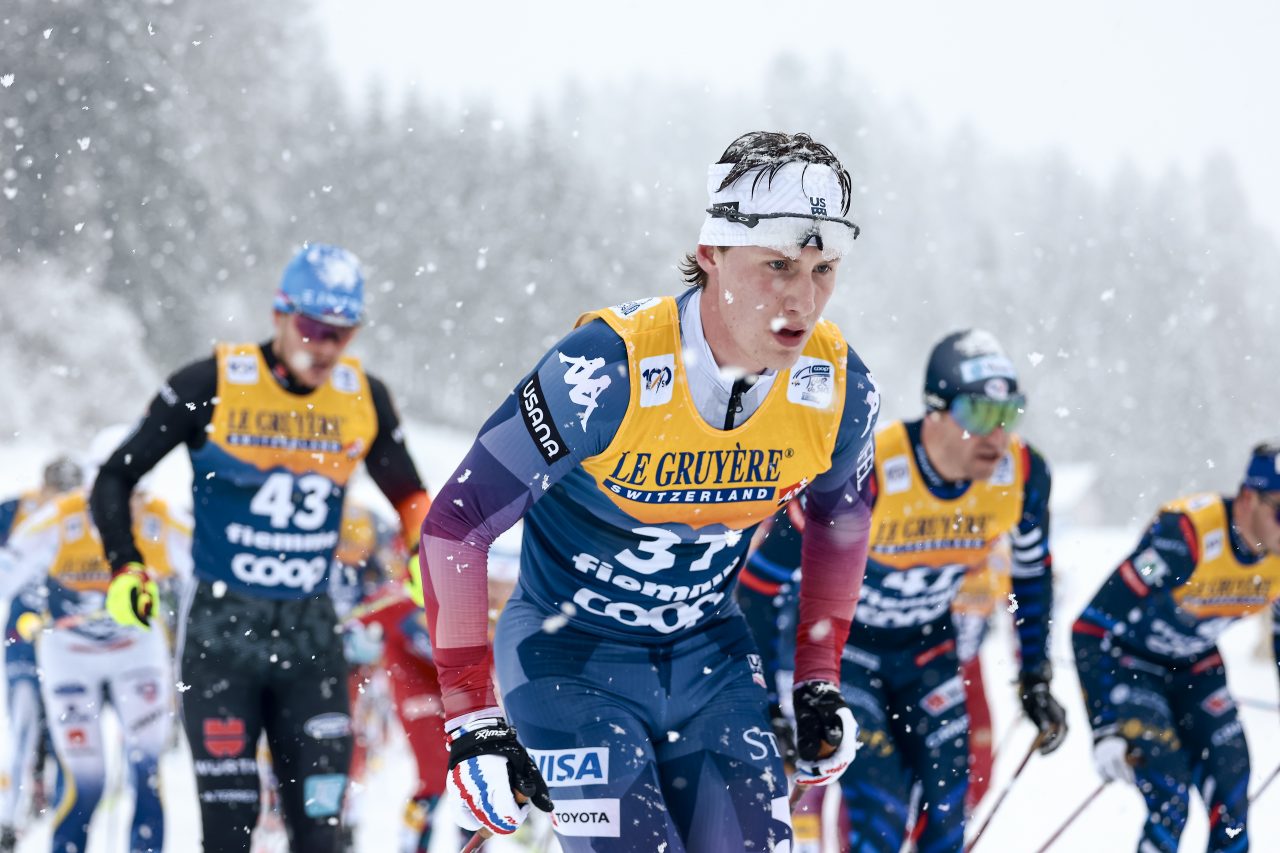
With only 2.5 k to go, it was still one giant pack with only 12 seconds between first and 51st. Amundsen, however, was leaving nothing to chance and went to the front. The virtual race for second and third in the TDS was still extremely tight with racers within a couple of seconds.
Even though the pack was close to the finish, the pace was still extremely relaxed. Several more skiers had tested the waters of going to the front only to abandon the opportunity after a few seconds. The race had now devolved into a giant touring pack with a Sprint finish looming. All the podium contenders were playing it safe with no one pushing the front, and everyone jockeying for a good spot for the finish.
With one kilometer to go, skiers began to seriously race. Cyril Faehndrich (SUI) (brother of Swiss star, Nadine Faehndrich), made a break with about half a kilometer to go. William Poromaa (SWE) and Valnes fell in behind him.
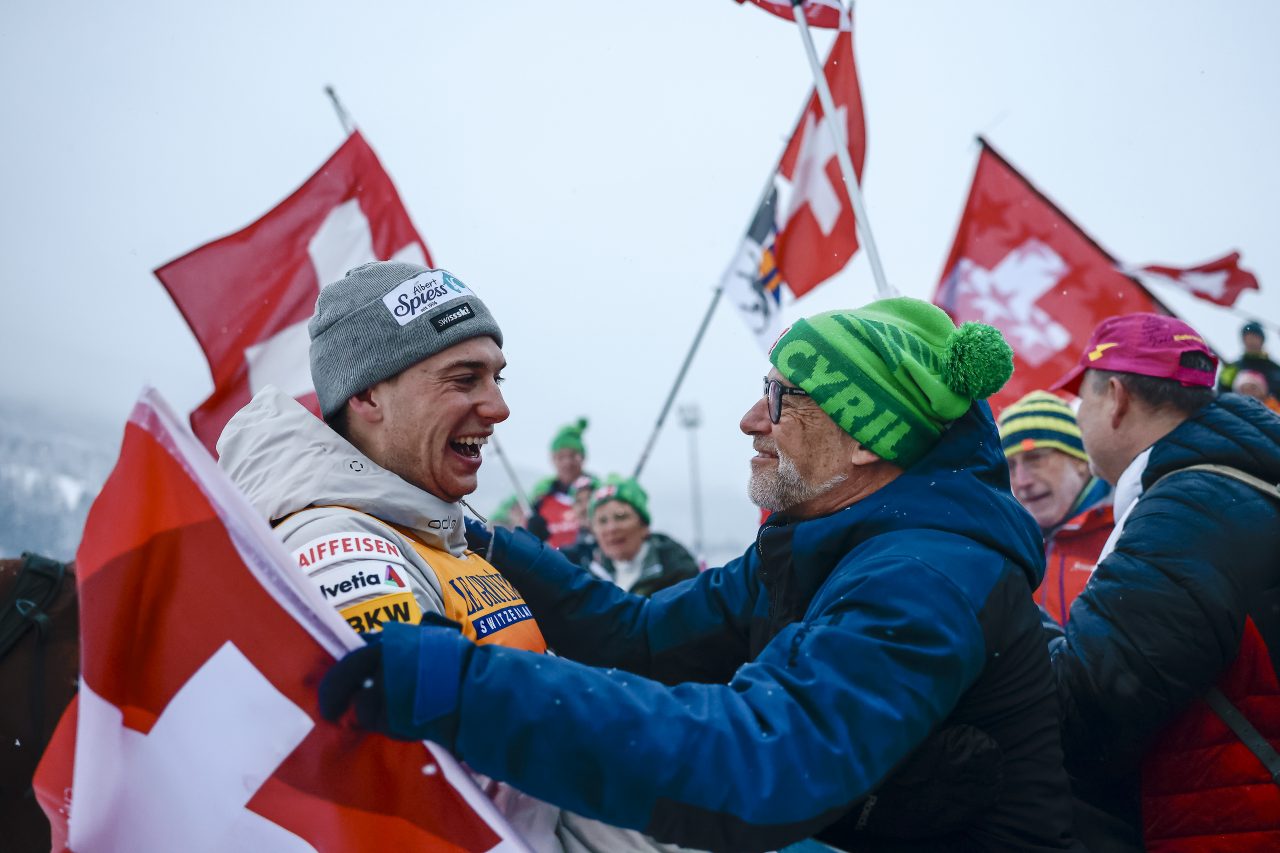
The race immediately became a three man sprint between Valnes, Faehndrich and Poromaa. In this situation, Valnes had the clear sprinting advantage. He double poled to the front and was able to push by Poromaa, who took second, and Faehndrich, who took third. For Faehndrich, it was his first World Cup podium. Tour leader Amundsen was only eight seconds behind the group and played a tactically smart race by not taking chances and preserving his large advantage going into tomorrow’s finale. While not the most thrilling race, it was smart tactics by the top contenders who were betting on making a bid in tomorrow’s climb up Alpe Cermis.
The racing strategy and weather created an interesting finishing time, where the winner of the men’s race was only three minutes faster than the Women’s winner!
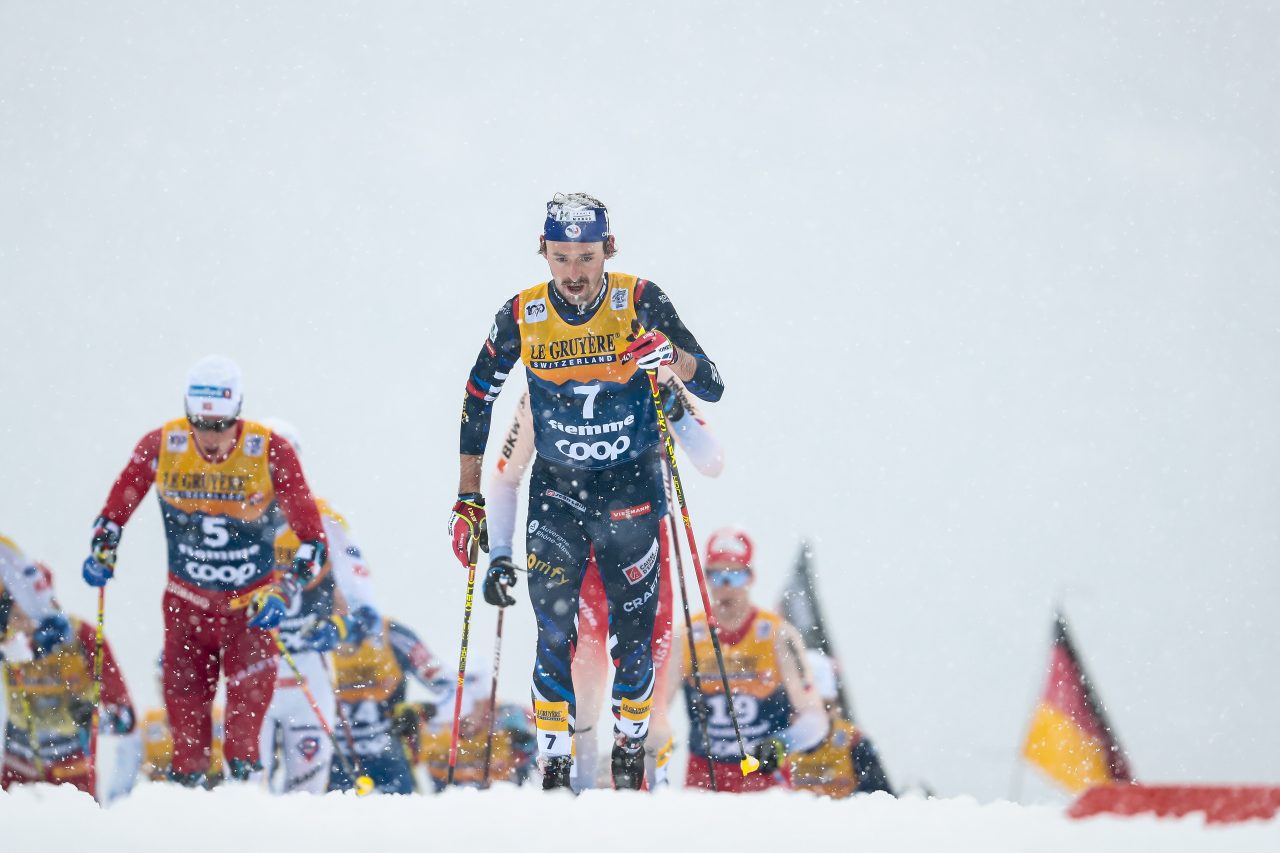
Impact on Tour de Ski Standings
Today’s race was really just about setting things up for tomorrow’s finale. Amundsen now has a 1:34 lead over teammate Erik Valnes, and a 1:42 lead over Martin Nyenget. But the race for second and third is still very tight. Lapalus, Moch, Klee, and Doennestad are all within seconds of the podium; tomorrow’s fight for second and third will be intense.
Men’s 15 Kilometer Mass Start Results
